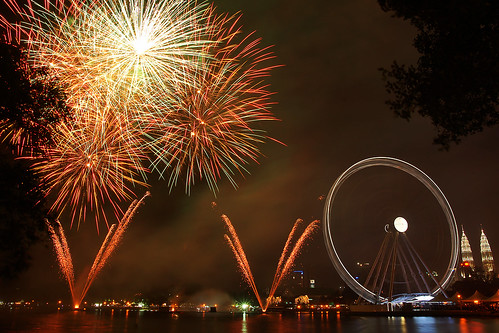Tips on How to Photograph Fourth of July Fireworks
How many years in a row have you tried to capture great fireworks pictures at the 4th of July show, only to come away with dark, blurry, or grainy shots? Here are some tips from photographer Michael Freeman, author of more than 20 photographic books including The Photographer’s Eye. Michael was recently featured in this month’s New York Times article, “Gadgetwise: Five Tips to Avoid Travel Photo Clichés.”
Prepare
Once in position at the fireworks locale (early, and in a place where people’s heads won’t interfere with your photos!), experiment with framing your shot by trying out different positions on your zoom or interchangeable lenses, if your camera has them. It’s always helpful to have some buildings in view to give scale and anchor to your shot, but keep them low in the frame. When the fireworks begin, use the first few bursts to finalize your lens focal length and framing.
Mamas: What, no tripod?
Oh no! You don’t have a tripod, or worse- you’ve left it behind. You do have other options. First, find a solid surface close to head (or even waist) height that has an unobstructed view. Lay down something soft, such as a jacket— or even better, a Ziploc bag filled with beans or rice (yes, really, this will keep your camera steady once you’ve pressed it down firmly onto the bag.)
Use a long exposure
Keeping in mind that fireworks generally burst over a period of a second or two, you’ll need to leave your camera’s shutter open for at least that long. Longer doesn’t generally do any harm, as it is a night sky.
If your camera has it, choose B mode (shutter stays open for as long as you press the release). Though not many cameras have this, T mode is even better (shutter stays open until you press the release a second time). If your camera does not have B, go for one of the longer shutter speeds it offers, but you may miss some shots.
On B, you run some risk of camera shake, so press gently, and hold your finger very steady. Better still, use a remote release cable. Though it puts in a delay, you can also opt to use the self-timer.
Low ISO
Normally, you might be thinking high ISO to make the camera more sensitive to low light, but in this case there will be plenty of illumination from the firebursts, so keep the ISO as low as it goes (ISO 100, for instance). That way, you’ll eliminate the risk of a noisy image that will ‘dirty’ the sky and and spoil the brilliant effect of the fireworks.
No flash needed
Not only does flash not reach very far, but the fireworks are the lighting! You don’t want to look like someone who didn’t know that just because your camera flashes automatically— Turn it off!
Focal Length
You’ll likely want the fireworks to fill the frame, and accomplishing that depends on how close you are and how the show was formatted. You already made a best guess for framing (1, above), but be prepared to re-adjust your zoom or fit a different lens. If you’re close, it’s quite likely you’ll need a wide-angle lens (which you’ll already have at the ready!
Michael Freeman is a renowned international photographer and writer who specializes in travel, architecture, and Asian art. He has been a leading photographer for the Smithsonian magazine for many years, and has worked for Time-Life Books and Reader’s Digest.

